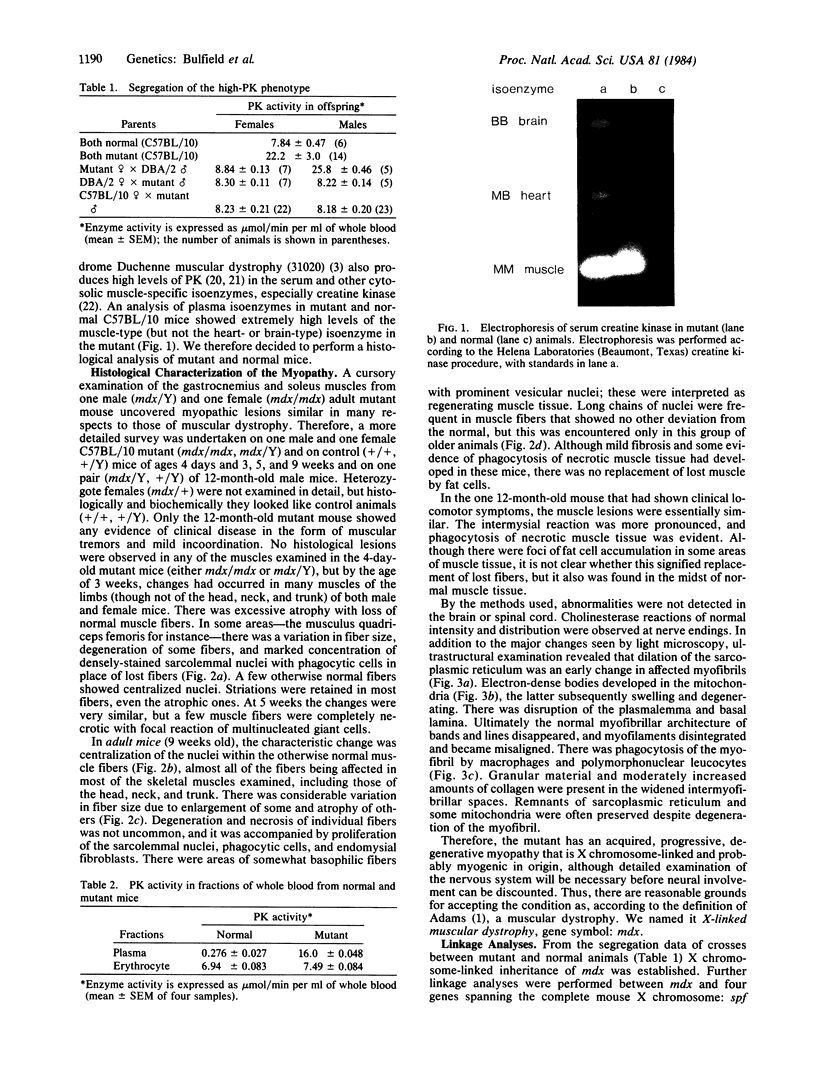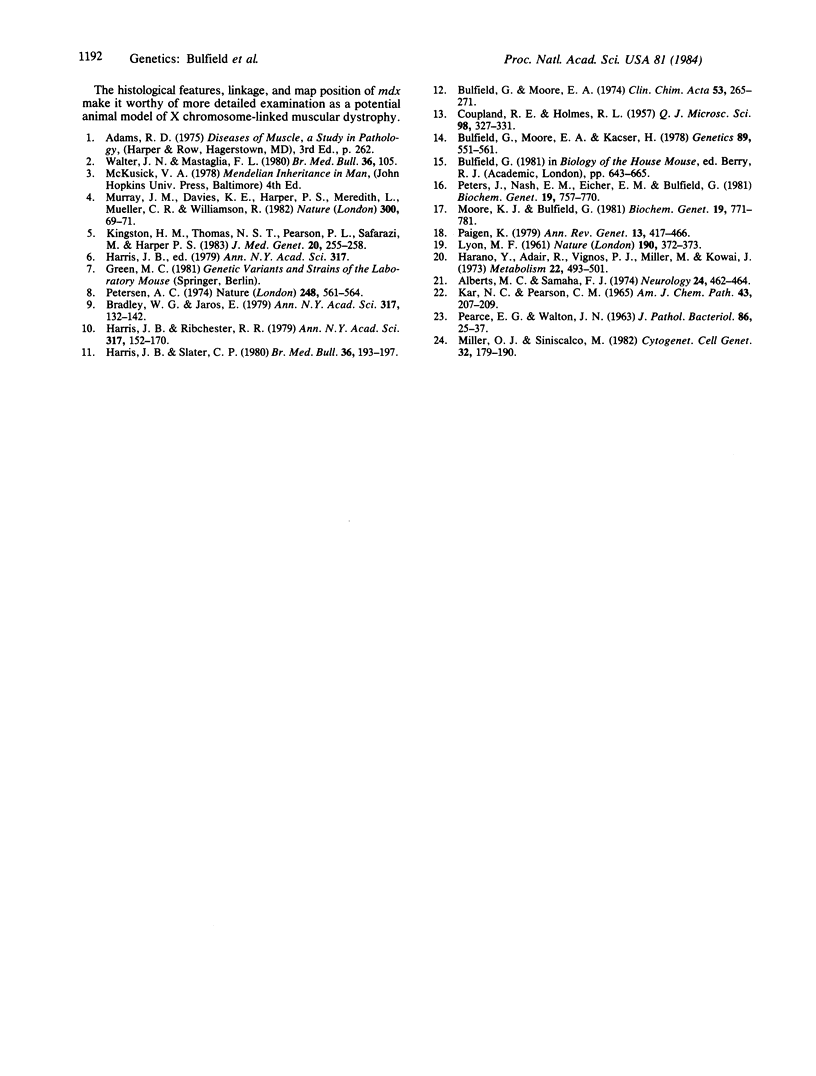Abstract
An X chromosome-linked mouse mutant (gene symbol, mdx) has been found that has elevated plasma levels of muscle creatine kinase and pyruvate kinase and exhibits histological lesions characteristic of muscular dystrophy. The mutants show mild clinical symptoms and are viable and fertile. Linkage analysis with four X chromosome loci indicates that mdx maps in the Hq Bpa region of the mouse X chromosome. This gives a gene order of mdx-Tfm-Pgk-1-Ags, the same as for the equivalent genes on the human X chromosome.
Full text
PDF



Images in this article
Selected References
These references are in PubMed. This may not be the complete list of references from this article.
- Alberts M. C., Samaha F. J. Serum pyruvate kinase in muscle disease and carrier states. Neurology. 1974 May;24(5):462–464. doi: 10.1212/wnl.24.5.462. [DOI] [PubMed] [Google Scholar]
- Bradley W. G., Jaros E. Involvement of peripheral and central nerves in murine dystrophy. Ann N Y Acad Sci. 1979;317:132–142. [PubMed] [Google Scholar]
- Bulfield G., Moore E. A., Kacser H. Genetic variation in activity of the enzymes of glycolysis and gluconeogenesis between inbred strains of mice. Genetics. 1978 Jul;89(3):551–561. doi: 10.1093/genetics/89.3.551. [DOI] [PMC free article] [PubMed] [Google Scholar]
- Bulfield G., Moore E. A. Semi-automated assays for enzymopathies of carbohydrate metabolism in liver and erythrocytes, using a reaction rate analyser. Clin Chim Acta. 1974 Jun 19;53(2):265–271. doi: 10.1016/0009-8981(74)90108-9. [DOI] [PubMed] [Google Scholar]
- Harano Y., Adair R., Vignos P. J., Jr, Miller M., Kowal J. Pyruvate kinase isoenzymes in progressive muscular dystrophy and in acute myocardial infarction. Metabolism. 1973 Mar;22(3):493–501. doi: 10.1016/0026-0495(73)90041-3. [DOI] [PubMed] [Google Scholar]
- Harris J. B., Ribchester R. R. Muscular dystrophy in the mouse: neuromuscular transmission and the concept of functional denervation. Ann N Y Acad Sci. 1979;317:152–170. doi: 10.1111/j.1749-6632.1979.tb56522.x. [DOI] [PubMed] [Google Scholar]
- Harris J. B., Slater C. R. Animal models: what is their relevance to the pathogenesis of human muscular dystrophy? Br Med Bull. 1980 May;36(2):193–197. doi: 10.1093/oxfordjournals.bmb.a071637. [DOI] [PubMed] [Google Scholar]
- KAR N. C., PEARSON C. M. CREATINE PHOSPHOKINASE ISOENZYMES IN MUSCLE IN HUMAN MYOPATHIES. Am J Clin Pathol. 1965 Mar;43:207–209. doi: 10.1093/ajcp/43.3.207. [DOI] [PubMed] [Google Scholar]
- Kingston H. M., Thomas N. S., Pearson P. L., Sarfarazi M., Harper P. S. Genetic linkage between Becker muscular dystrophy and a polymorphic DNA sequence on the short arm of the X chromosome. J Med Genet. 1983 Aug;20(4):255–258. doi: 10.1136/jmg.20.4.255. [DOI] [PMC free article] [PubMed] [Google Scholar]
- LYON M. F. Gene action in the X-chromosome of the mouse (Mus musculus L.). Nature. 1961 Apr 22;190:372–373. doi: 10.1038/190372a0. [DOI] [PubMed] [Google Scholar]
- Miller O. J., Siniscalco M. Report of the committee on the genetic constitution of the x and y chromosomes. Oslo Conference (1981): Sixth International Workshop on Human Gene Mapping. Cytogenet Cell Genet. 1982;32(1-4):179–190. doi: 10.1159/000131697. [DOI] [PubMed] [Google Scholar]
- Moore K. J., Bulfield G. An allele (Pk-1b) from wild-caught mice that affects the activity and kinetics of erythrocyte and liver pyruvate kinase. Biochem Genet. 1981 Aug;19(7-8):771–781. doi: 10.1007/BF00484008. [DOI] [PubMed] [Google Scholar]
- Murray J. M., Davies K. E., Harper P. S., Meredith L., Mueller C. R., Williamson R. Linkage relationship of a cloned DNA sequence on the short arm of the X chromosome to Duchenne muscular dystrophy. Nature. 1982 Nov 4;300(5887):69–71. doi: 10.1038/300069a0. [DOI] [PubMed] [Google Scholar]
- PEARCE G. W., WALTON J. N. A histological study of muscle from the Bar Harbor strain of dystrophic mice. J Pathol Bacteriol. 1963 Jul;86:25–33. doi: 10.1002/path.1700860105. [DOI] [PubMed] [Google Scholar]
- Paigen K. Acid hydrolases as models of genetic control. Annu Rev Genet. 1979;13:417–466. doi: 10.1146/annurev.ge.13.120179.002221. [DOI] [PubMed] [Google Scholar]
- Peters J., Nash H. R., Eicher E. M., Bulfield G. Polymorphism of kidney pyruvate kinase in the mouse is determined by a gene, Pk-3, on chromosome 9. Biochem Genet. 1981 Aug;19(7-8):757–769. doi: 10.1007/BF00484007. [DOI] [PubMed] [Google Scholar]
- Peterson A. C. Chimaera mouse study shows absence of disease in genetically dystrophic muscle. Nature. 1974 Apr 12;248(449):561–564. doi: 10.1038/248561a0. [DOI] [PubMed] [Google Scholar]





